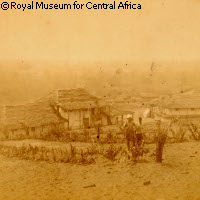Study puts HIV's origins at turn of 20th century
A new study suggests that the HIV (human immunodeficiency virus) started to spread among humans at the beginning of the 20th century, driven by the rapid growth of new cities, and an associated rise in risky behaviours, in colonial central Africa. The research, which was carried out by scientists from Europe, Africa, the US and Australia, is published in the latest edition of the journal Nature. HIV probably arose when humans living in the forests of central Africa butchered meat from chimpanzees infected with a related virus called SIV (simian immunodeficiency virus). Previous studies concluded that HIV first started to circulate in the human population in the 1930s. However, this latest study reveals that the virus may have started to circulate in Léopoldville (now Kinshasa, Democratic Republic of Congo) as early as the 1880s. At that time, Léopoldville was the largest city in the Belgian Congo. Before the turn of the 20th century there were no large cities in central Africa. The scientists speculate that the expansion of colonial cities such as Léopoldville led to a rise in risky behaviours such as unsafe sex, effectively fuelling the spread of the disease. Studying the history of the HIV virus is not easy; there are few known samples of the disease dating from before the 1980s, when AIDS (Acquired Immune Deficiency Syndrome) was first officially described. In a bid to find older samples of the virus, the scientists trawled through tissue samples archived in central Africa. Their search brought to light the second-oldest sample of the HIV virus discovered so far, in the form of a lymph-node biopsy taken from a woman in Kinshasa in 1960. They then compared the genetic sequences of this virus sample with the oldest known HIV sample, which was found in a blood sample taken from a man in Kinshasa in 1959, and other more recent samples of the virus. The HIV virus mutates at a fairly steady rate. By comparing the differences in the DNA of the various samples, the scientists were able to calculate when HIV first arose. Interestingly, the two 'ancient' samples from Kinshasa turned out to have a large number of differences, indicating that the virus had already been circulating in Kinshasa for a number of decades before these samples were taken. 'Our estimation of divergence times [...] indicates that these viruses evolved from a common ancestor circulating in the African population near the beginning of the 20th century,' the scientists write. After its arrival in the human population, the virus spread relatively slowly during the first half of the century but by the 1960s many people in the central African region were infected. The virus then began to spread around the world and was finally identified in the 1980s. 'Previous work on HIV sequencing had been done on frozen samples and there are only so many of those samples available,' explained Professor Michael Worobey of the University of Arizona in the US, noting that after the Kinshasa samples, the next oldest samples of the virus date from the late 1970s and early 1980s. 'Now, for the first time, we have been able to compare two relatively ancient HIV strains,' added Professor Worobey. 'That helped us to calibrate how quickly the virus evolved and make some really robust inferences about when it crossed into humans, how quickly the epidemic grew from that time and what factors allowed the virus to enter and become a successful human pathogen.' The fact that the common ancestor of the HIV virus dates from the same period as the construction of the first towns in the region leads the scientists to speculate that 'the rise of cities may have facilitated the initial establishment and spread of HIV-1. 'Hence, the founding and growth of colonial administrative and trading centres such as Kinshasa may have enabled the region to become the epicentre of the HIV/AIDS pandemic,' they conclude. Professor Worobey believes his team's findings are cause for optimism that the disease will one day be beaten. 'I think the picture that has emerged here, where changes [that] the human population [has] experienced may have opened the door to the spread of HIV, is a good reminder that we can make changes now that could help reverse the epidemic,' he commented. 'If HIV has one weak spot, it is that it is a relatively poorly transmitted virus. From better testing and prevention to wider use of antiretroviral drug therapy, there are a number of ways to reduce transmission and force this virus back into extinction. Our results suggest that there are reasons for such optimism.' Meanwhile, the team is keen to find out if there are more samples of the virus lying hidden in other samples taken decades ago and stored in the archives of central African hospitals. 'A deep perspective on the evolutionary history of HIV-1 using sequences resurrected from the earliest cases in Africa could yield important insights into the pathogenesis, virulence and evolution of pandemic AIDS viruses,' they write.
Countries
Australia, Belgium, Congo, Denmark, France, United States



